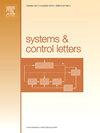相互依存和切换多代理系统的分布式状态估计
IF 2.1
3区 计算机科学
Q3 AUTOMATION & CONTROL SYSTEMS
引用次数: 0
摘要
研究了有向图交换网络中多智能体分布式状态估计问题。具体来说,我们考虑了线性连续时间系统的一种新的估计设置,该系统被分解为多个子系统,每个子系统由相应的代理进行局部估计。尽管由于网络和物理层面上的相互依赖,以及由于系统正在切换的事实,即不同的子系统/代理可以激活(例如,完成某些特定的任务)或停用(例如,由于故障),在以代理未知的截止时间结束的瞬态期间,该任务被承担,之后拓扑变得固定。特别是,通过利用可负性——如果存在反馈增益K使得A - KC是负确定的,则对(A,C)是可负的——每个代理都能够在局部执行其自己的估计增益矩阵的计算。利用非光滑分析对估计误差进行了收敛性分析,并通过仿真验证了所提结果的有效性。本文章由计算机程序翻译,如有差异,请以英文原文为准。
Distributed state estimation for interdependent and switching multi-agent systems
This paper addresses the problem of multi-agent distributed state estimation in switching networks over directed graphs. Specifically, we consider a novel estimation setting for a linear continuous-time system that is broken down into subsystems, each of which is locally estimated by the corresponding agent. This task is undertaken despite the complexities due to interdependencies on both cyber and physical levels, and due to the fact that the system is switching, i.e., the different subsystems/agents can activate (e.g., to accomplish some specific task) or deactivate (e.g., due to a fault) during a transient that ends with a cutoff time, unknown to the agents, after which the topology becomes fixed. In particular, by exploiting the negativizability property – the pair is negativizable if there is a feedback gain such that is negative definite – each agent is able to locally perform the calculation of its own estimation gain matrix. The paper is complemented by the convergence analysis of the estimation error executed by leveraging on nonsmooth analysis and simulations to prove the effectiveness of the proposed results.
求助全文
通过发布文献求助,成功后即可免费获取论文全文。
去求助
来源期刊

Systems & Control Letters
工程技术-运筹学与管理科学
CiteScore
4.60
自引率
3.80%
发文量
144
审稿时长
6 months
期刊介绍:
Founded in 1981 by two of the pre-eminent control theorists, Roger Brockett and Jan Willems, Systems & Control Letters is one of the leading journals in the field of control theory. The aim of the journal is to allow dissemination of relatively concise but highly original contributions whose high initial quality enables a relatively rapid review process. All aspects of the fields of systems and control are covered, especially mathematically-oriented and theoretical papers that have a clear relevance to engineering, physical and biological sciences, and even economics. Application-oriented papers with sophisticated and rigorous mathematical elements are also welcome.
 求助内容:
求助内容: 应助结果提醒方式:
应助结果提醒方式:


